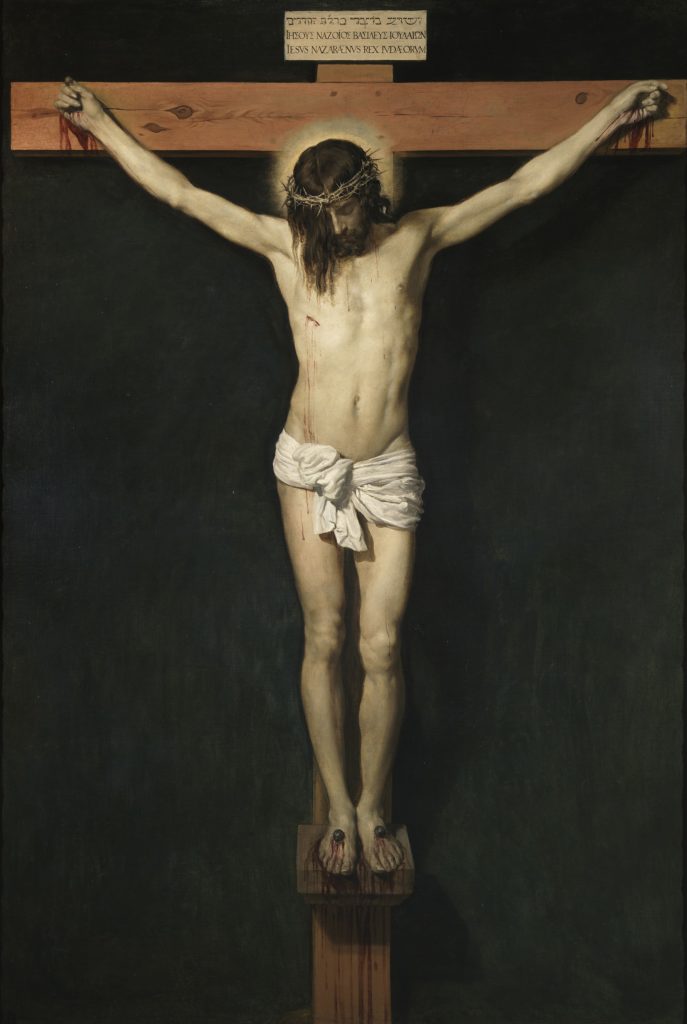Father Bruno Holtz, who for decades was one of the pillars of the Œuvre St-Justin in Fribourg and Geneva, had written, shortly before his death in February 2012, a series of eighteen “tableaux” to popularize the life and thought of the 2nd-century Christian philosopher Saint Justin, patron saint of our Œuvre. In this 15th episode, Justin talks about the meaning of Jesus’ death on the cross.
In his Dialogue with Tryphon, Justin speaks several times of Christ’s death on the cross. Tryphon quotes him from the book of Deuteronomy, where it is said that to die on a cross is a curse. Justin replies that the cross, Christ’s death on the cross, is precisely the event that saves humanity from sin and death. Moses’ prayer with outstretched arms, which gave victory to the Hebrews, is a sign of the victory Christ won by dying on the cross. The Tree of Life in paradise is the proclamation of the Life Christ gives to mankind through the tree of the cross. Justin goes on to say that the wood of the ark, which saved Noah and his family, is a sign of the Salvation for mankind acquired through the wood of the cross.
But the most important witness to Old Testament prophecy for Justin is Psalm 21, which he analyzes phrase by phrase, devoting eight chapters of his Dialogue with Tryphon to it.
It is Christ who says, as he hangs on the cross, “My God, my God, why have you forsaken me?” It’s Christ who says, “I’m a worm, not a man, mocked by the people, rejected by the people. All who see me scorn me, they sneer and shake their heads.” And again: “He was counting on the Lord: let him deliver him! May he save him, since he is his friend!”
The analysis continues: “I’m like water pouring out, all my limbs are dislocated. My heart is like wax, melting in my bowels. My vigor has dried up like clay, my tongue sticks to my palate.” And further on: “These people are watching me. They divide my clothes among themselves and cast lots for my garment.” Justin concludes his analysis of the Psalm with the praise of God that forms its final section.
Another of Justin’s testimonies to salvation and healing through the cross is the brazen serpent on a staff, which the snake-bitten Hebrews had to look at to be healed. For Justin, the staff is the wood of the cross, the serpent the fallen angel who succeeded in bringing down Adam and Eve. Behind the serpent, Justin sees the body of Christ, who has conquered death.
Among many other references, let’s mention a brief text from the prophet Isaiah: “I said, ‘Here I am to the nations, to those who do not call on my name. All day long I have stretched out my hands to an unfaithful and contradictory people, to those who walked not in a good way, but as a result of their sins.”

Summary
- Edito | Pentecost in our hearts!
- REPORTS 2024 | 2024, first year of the Fondation
- REPORT 2024 | Foyer of Fribourg
- REPORT 2024 | Foyer of Geneva and Lausanne
- REPORT 2024 | Foyer of Valais
- REPORT 2024 | Foyer Zurich “Justinus House”
- REPORT 2024 | Accounts 2024
- Philately | IMPORTANT DATES
- Giving joy, here and elsewhere | How can you help us accomplish our mission?
- TESTIMONIAL | Marco Cattaneo : “I didnt think I would stay long in St-Justin”
- St-Rita’s Celebration 2025 | To offer a little joy
- SPIRITUALITY | Testimony to joyful faith in Jesus the Savior
- NEWS | Celebrating St-Justin, 1st of June 2025
- GENIUS OF CHRISTIANITY 15/18 | The scandal of the cross
- NEWS | Retirement celebration of the Director